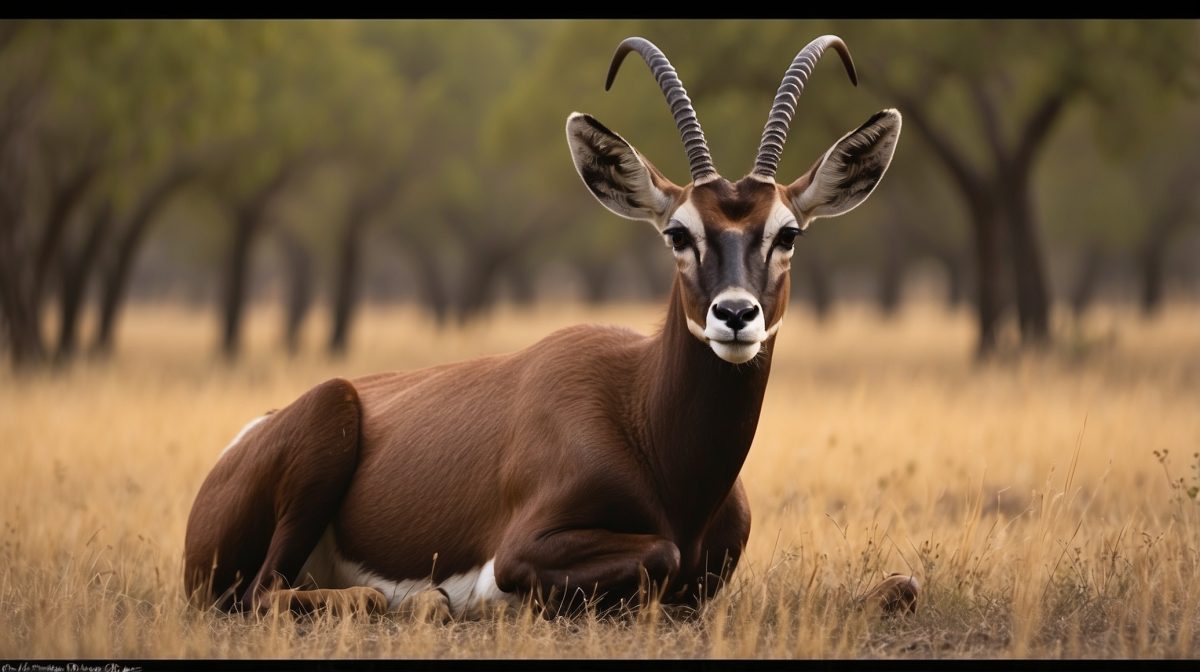The Blackbuck Antelope
Now, the blackbuck antelope ain’t originally from around these parts. They were brought over from the Indian subcontinent way back when, and since then, they’ve become as much a part of Texas as brisket and bluebonnets. These critters are easy to spot with their long, spiraled horns and distinctive two-tone coloration, which makes ’em a favorite among local wildlife enthusiasts and photographers alike.
But it ain’t just their looks that make ’em special. Blackbucks hold a place in the hearts of Texans, symbolizin’ the diversity and adaptability of our wildlife. They’ve been integrated into our culture and are a prized species for hunters and conservationists both. Their presence here is a testament to the rich tapestry of life in the Texas Hill Country.
Behavior Patterns of the Blackbuck Antelope
Blackbuck antelope are social critters, often seen in herds with a complex social structure. The males are territorial, especially during the breeding season, and they’ll put on quite a show to defend their turf. These displays are something to behold, with males leaping and prancing to assert dominance and attract the ladies.
These antelopes are most active when the sun’s rays are gentle, during the cooler parts of the day. You’ll find ’em grazing in the open grasslands, where they can keep an eye out for predators. They’ve got a keen sense of their place in the food chain and are always on alert, which is why you’ll often see them in areas with good visibility. It’s this instinctual behavior that keeps ’em thriving in the wild.
The Perfect Habitat
For blackbuck antelope to flourish, they need the right mix of open grasslands for grazing and scattered brush for cover. The Texas Hill Country’s unique terrain, with its rolling hills and varied vegetation, provides just the right kind of environment for these animals. Plus, the climate here is to their likin’, with hot summers and mild winters that mimic their native lands.
Despite their exotic origins, blackbucks have shown a remarkable ability to adapt to the changing Texas landscapes. Whether it’s the semi-arid regions or the more lush areas of the Hill Country, these antelope have proven they can handle it all. This adaptability is key to their survival and a testament to the resilience of nature.
Conservation Efforts and Responsible Hunting
Conservin’ the blackbuck antelope population is crucial, and it takes a careful balance of protection and controlled hunting. Places like the JL Bar Ranch Resort have taken up the mantle to ensure these animals continue to grace our lands. They manage their numbers, provide ideal habitats, and work to keep the herds healthy and strong.
Guided trophy hunts, when done responsibly, can actually support conservation efforts. By maintainin’ a sustainable population and fundin’ habitat management, these hunts play a part in the bigger picture of wildlife preservation. Hunters at the JL Bar Ranch Resort are part of this cycle, contributing to the conservation of the species while experiencing the thrill of the hunt.
Blackbuck Antelope and the Texan Ecosystem
The blackbuck antelope ain’t just another pretty face in the Texas Hill Country; they’re a vital component of our ecosystem. Their grazing habits help to maintain the health of our grasslands, and they serve as prey for native predators, keepin’ the food chain in balance. It’s a delicate dance between every creature, and the blackbuck plays its part with grace.
But it ain’t just about lettin’ nature take its course. We’ve got to manage these animals wisely to ensure they don’t negatively impact our native species. That’s where land management strategies come in, helpin’ to preserve the harmony between blackbucks and the rest of our Texan wildlife. It’s all about respectin’ the land and every critter that calls it home.
Conclusion
We’ve covered quite a bit of ground here, folks. From understanding the intricate behavior of the blackbuck antelope to appreciating their role in the Texan landscape, it’s clear these animals are a true gem of the Hill Country. They’re not just a sight to behold; they’re an integral part of our ecosystem here, and it’s up to us to ensure their survival for generations to come.
FAQs
Why were blackbuck antelope introduced to Texas?
Blackbuck antelope were brought to Texas for game hunting and to add diversity to the wildlife population. They’ve since become a beloved part of the Texan ecosystem.
What do blackbuck antelope eat and how do they affect the local vegetation?
Blackbuck antelope primarily graze on grasses, which can help maintain healthy grassland ecosystems when managed properly.
Can blackbuck antelope be seen year-round in the Texas Hill Country?
Yes, blackbuck antelope are a common sight throughout the year in the Texas Hill Country.
How does the JL Bar Ranch Resort manage their blackbuck antelope populations?
The JL Bar Ranch Resort manages their blackbuck populations through habitat conservation, controlled hunting, and population monitoring to ensure a healthy and sustainable herd.
What can I do to support blackbuck antelope conservation efforts in Texas?
You can support conservation efforts by visiting wildlife reserves, participating in responsible wildlife tourism, and contributing to organizations dedicated to the preservation of these species.


